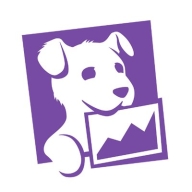

Datadog and DX Performance Management compete in the monitoring and application performance management space. Datadog often has the upper hand due to its advanced integration and visualization capabilities, though DX Performance Management aligns well with large infrastructure needs.
Features: Datadog offers a robust ecosystem with integration capabilities, customizable dashboards, and real-time log management. It provides visualization tools and a unified tagging system that simplifies monitoring and problem-solving. DX Performance Management focuses on easy data collection, foundational reporting, and can quickly discover devices to start monitoring.
Room for Improvement: Datadog users are looking for consistent APIs and more features for application-level insights, with pricing being a major concern. DX Performance Management needs enhancements in high availability and better integration with existing systems, with calls for improved reporting capabilities and easier administration.
Ease of Deployment and Customer Service: Datadog is flexible, supporting various environments like private, public, and hybrid clouds, backed by responsive technical support. DX Performance Management is ideal for on-premises deployment but needs faster support response times.
Pricing and ROI: Datadog is known for a high pricing model that may escalate with use, yet offers justified ROI due to its extensive troubleshooting features. DX Performance Management is valued for competitive pricing, though high upfront costs for large setups can be significant.
| Product | Market Share (%) |
|---|---|
| Datadog | 3.1% |
| DX Performance Management | 0.3% |
| Other | 96.6% |


| Company Size | Count |
|---|---|
| Small Business | 78 |
| Midsize Enterprise | 42 |
| Large Enterprise | 82 |
| Company Size | Count |
|---|---|
| Small Business | 5 |
| Large Enterprise | 25 |
Datadog integrates extensive monitoring solutions with features like customizable dashboards and real-time alerting, supporting efficient system management. Its seamless integration capabilities with tools like AWS and Slack make it a critical part of cloud infrastructure monitoring.
Datadog offers centralized logging and monitoring, making troubleshooting fast and efficient. It facilitates performance tracking in cloud environments such as AWS and Azure, utilizing tools like EC2 and APM for service management. Custom metrics and alerts improve the ability to respond to issues swiftly, while real-time tools enhance system responsiveness. However, users express the need for improved query performance, a more intuitive UI, and increased integration capabilities. Concerns about the pricing model's complexity have led to calls for greater transparency and control, and additional advanced customization options are sought. Datadog's implementation requires attention to these aspects, with enhanced documentation and onboarding recommended to reduce the learning curve.
What are Datadog's Key Features?In industries like finance and technology, Datadog is implemented for its monitoring capabilities across cloud architectures. Its ability to aggregate logs and provide a unified view enhances reliability in environments demanding high performance. By leveraging real-time insights and integration with platforms like AWS and Azure, organizations in these sectors efficiently manage their cloud infrastructures, ensuring optimal performance and proactive issue resolution.
CA Performance Management is a comprehensive and highly scalable network performance monitoring and analytics platform. It was built to meet the unique demands of big data and modern networks architectures, including highly dynamic and complex hybrid cloud and software-defined networks (SDN).
The platform is design to reduce complexity inherent in modern networks built across numerous technology stacks through advanced network performance monitoring and relationship mapping for improved operational assurance.
Combined with CA Virtual Network Assurance, the platform extends operator visibility through advanced discovery and network performance monitoring of highly sensitive cloud and multi-layered SDN networks and service chains.
We monitor all Network Monitoring Software reviews to prevent fraudulent reviews and keep review quality high. We do not post reviews by company employees or direct competitors. We validate each review for authenticity via cross-reference with LinkedIn, and personal follow-up with the reviewer when necessary.